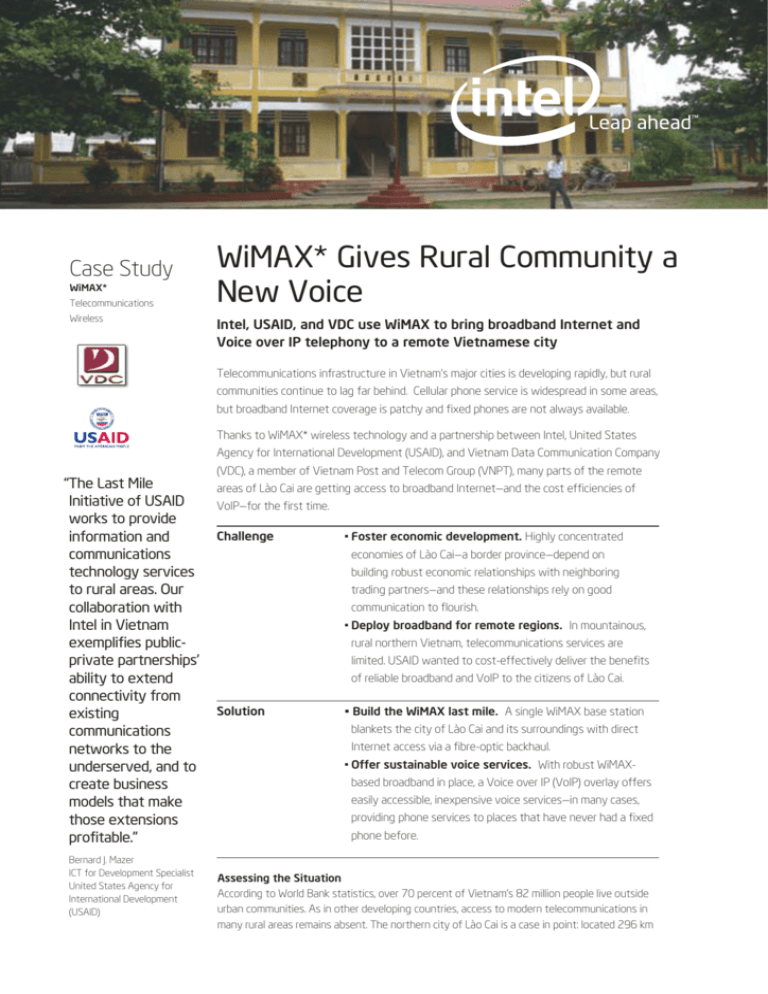
Case Study
WiMAX*
Telecommunications
Wireless
WiMAX* Gives Rural Community a
New Voice
Intel, USAID, and VDC use WiMAX to bring broadband Internet and
Voice over IP telephony to a remote Vietnamese city
Telecommunications infrastructure in Vietnam’s major cities is developing rapidly, but rural
communities continue to lag far behind. Cellular phone service is widespread in some areas,
but broadband Internet coverage is patchy and fixed phones are not always available.
Thanks to WiMAX* wireless technology and a partnership between Intel, United States
Agency for International Development (USAID), and Vietnam Data Communication Company
(VDC), a member of Vietnam Post and Telecom Group (VNPT), many parts of the remote
“The Last Mile
Initiative of USAID
works to provide
information and
communications
technology services
to rural areas. Our
collaboration with
Intel in Vietnam
exemplifies publicprivate partnerships’
ability to extend
connectivity from
existing
communications
networks to the
underserved, and to
create business
models that make
those extensions
profitable.”
Bernard J. Mazer
ICT for Development Specialist
United States Agency for
International Development
(USAID)
areas of Lào Cai are getting access to broadband Internet—and the cost efficiencies of
VoIP—for the first time.
Challenge
• Foster economic development. Highly concentrated
economies of Lào Cai—a border province—depend on
building robust economic relationships with neighboring
trading partners—and these relationships rely on good
communication to flourish.
• Deploy broadband for remote regions. In mountainous,
rural northern Vietnam, telecommunications services are
limited. USAID wanted to cost-effectively deliver the benefits
of reliable broadband and VoIP to the citizens of Lào Cai.
Solution
• Build the WiMAX last mile. A single WiMAX base station
blankets the city of Lào Cai and its surroundings with direct
Internet access via a fibre-optic backhaul.
• Offer sustainable voice services. With robust WiMAXbased broadband in place, a Voice over IP (VoIP) overlay offers
easily accessible, inexpensive voice services—in many cases,
providing phone services to places that have never had a fixed
phone before.
Assessing the Situation
According to World Bank statistics, over 70 percent of Vietnam’s 82 million people live outside
urban communities. As in other developing countries, access to modern telecommunications in
many rural areas remains absent. The northern city of Lào Cai is a case in point: located 296 km
Wireless WiMAX* service blankets one of Vietnam’s most
remote provinces with robust broadband Internet and
cost-effective Voice over IP
from Vietnam’s capital Hanoi by railway, and 345 km
by roadway, the city is the economic centre of a rural
agricultural province. Lào Cai province’s approximately
600,000 inhabitants, from 25 ethnic groups, made
up just 0.7 percent of the country’s population
in 2004.
While widespread cellular phone coverage provides
relatively good voice coverage across Lào Cai, no such
coverage exists for data services. Internet access
through dial-up connections is low and ponderous,
while the few available broadband options are limited
and expensive. Services available within the city area
drop off substantially in the rural areas just a few
kilometers from the city center, with many rural areas
relying on shared community phones.
In developing countries like Vietnam, where per—
capita gross domestic product (GDP) is just around
US$650 per year—and especially in poor regions like
mountainous Lào Cai province, where per-capita GDP
is around US$330—better broadband has traditionally
been low on the list of priorities. Ironically, areas like
Lào Cai require better communication to strengthen
nascent trade relationships with neighboring China
Spotlight: Lào Cai province, Vietnam
• Located on a floodplain in a mountainous
region in northern Vietnam, abutting the
border with China.
• Population of 600,000 inhabitants in 2004,
from 25 ethnic groups.
• One of Vietnam’s poorest regions, with
current per capita GDP of US$330.
• Traditional industries such as agriculture and
forestry are being complemented with efforts
to strengthen cross-border trade with China
and to attract foreign investment.
and with foreign investors—two sources of capital
flow that are judged as essential to the province’s
economic growth.
For this reason, the city was a natural choice as the
location for a revolutionary pilot test conducted
through a partnership between Intel, USAID, and VDC.
As a leading player in Vietnam's telecom market, VDC
has a strategic plan to deploy advanced technologies
for expanding areas covered by services such as
broadband Internet and VoIP.
USAID’s Last Mile Initiative (LMI) is a global
program launched in April 2004 to bring modern
communications infrastructure to farmers and
small businesses in rural areas that have been
ignored by the development of the world’s major
telecommunications networks. In addition to
Vietnam, programs are being undertaken in countries
including Guatemala, Ethiopia, Macedonia, Nigeria,
Peru, and Sri Lanka.
The goals of LMI reflect those of the Intel® World
Ahead Program, a five-year, $US1 billion investment
to bring uncompromised technology to developing
countries. World Ahead represents Intel’s commitment
to helping bridge the digital divide between
developed and developing countries, improving
accessibility, connectivity, education, and content.
The program’s goal, as stated by Intel Chairman
of the Board Craig Barrett, is “to develop an
integrated region of connected villages, municipalities,
and countries that can enjoy the full capabilities
of technology.”
The Intel World Ahead Program aims to enhance lives
by accelerating access to uncompromised
technology for everyone, anywhere in the world.
Focused on the world’s developing communities, it
integrates and extends Intel’s efforts to advance
four areas: accessibility, connectivity, education, and
content. Intel’s goal is not only to extend affordable
PC access but to develop the PCs tailored to local
needs, drive critical connectivity, cultivate
sustainable local capabilities, and provide
technology education to make a meaningful
difference in people’s lives.
“Our public-private
partnership,
including Intel,
VNPT/VDC, Lào Cai
province, and
USAID, shares a
joint vision that
every person,
family, and
community in
Vietnam—no
matter where they
are located or how
far away they are
from urban centers
—can connect with
the international
‘knowledge
economy’ in ways
that uplift their life
and prospects for
the future.”
Jonathan Aloisi
Deputy Chief of Mission
U.S. Embassy to Vietnam
Lài Cai is such a place. Recognizing the potential
of WiMAX* to provide new benefits to the
citizens of the province, Intel, USAID, and VDC
developed a plan to use the technology to bring
them robust broadband Internet connectivity.
With broadband in place, those citizens would
also be well positioned to take advantage of
complementary technologies such as VoIP.
Delivering the Solution
With WiMAX recognized as a quick and easy
way to bring an Internet dialtone to Lào Cai,
appropriate technology was sourced and
implemented in the region by VDC with the
assistance of Vegastar.
Technology installed to support Lào Cai
citizens included an Alvarion BreezeMAX*
base station, nearly 20 WiMAX fixed—access
customer premises equipment (CPE) units,
wireless and wired VoIP phones, and related
networking infrastructure.
The BreezeMAX antenna was installed
70m above the ground on a local
telecommunications tower, with the base
station connected to a fibre-optic backhaul
service and the VoIP gateway linked to the
public switched telephony service. The LignUp
VoIP Communication Application Server* is
hosted from a site in Hanoi, while a session
border controller and VoIP gateway were
installed in Lào Cai province.
CPEs or WiMAX modems were installed in a
variety of settings throughout the region,
including the local post office, Internet café,
government office, secondary schools, healthcare centers, hotels, and a farm household
outside the city.
At sites like the healthcare center, the WiMAX
service was the first time broadband Internet
had been available. At each location, a Session
Initiation Protocol (SIP)-compatible VoIP phone
was linked to the CPE unit, providing both
broadband Internet access and a telephone
service with minimal setup cost and complexity.
Key Technologies
Integral Answers
• Alvarion BreezeMAX* provided WiMAX*
• Intel facilitated the overall project and
base station transmission using one Micro
provided high-level management to drive
BTS with omni-directional antenna and
the project to successful completion.
about 20 BreezeMAX CPE devices.
• LignUp’s Voice over IP (VoIP) switch, plus
a session border controller and VoIP
gateway.
• Wireless and wired VoIP phones, as well
as analog phones with analog telephone
adapter (ATA) gateways, used for phone
• VDC provided system integration
and broadband Internet access to
Lào Cai’s citizens.
• Vegastar provided wireless technical
expertise for the full solution.
• Alvarion provided WiMAX* equipment and
configuration expertise.
calling.
• LignUp’s specialized VoIP technology
brought a dial tone to anyone within the
WiMAX coverage area.
With the success of the Lào Cai deployment, the Intel, USAID, and
VDC partnership is now laying plans for a second rollout, in a
nearby mountainous area with no fibre backhaul. In that rollout,
the WiMAX base station will be linked to an IPStar satellite
backhaul service to provide broadband Internet and VoIP services
throughout the area.
Each successful rollout confirms the importance of initiatives
like USAID’s LMI and the Intel World Ahead Program. WiMAX
allows quick and cost-effective deployment of communications
services independent of the quality of local telecommunications
infrastructure—making it a key tool in the global effort to give
developing countries access to first-world information and
communications technologies.
And while the benefits of the solution may begin with the
welcome surprise of broadband Internet access and improved
telephone service, they will become truly clear as local economic
and social development capitalizes upon the possibilities of Lào
Cai’s newfound connectivity.
Return on Investment
• WiMAX* availability means any resident or business in
Lào Cai and its rural surroundings—where there is no
Internet access at all—can now get online.
• Layering low-cost VoIP services on top of the WiMAX
service brings easy telephony access to places that
previously relied on cellular phone service, or had no
phone service at all.
• The low cost of VoIP services promises equitable access to
communications services in one of Vietnam’s poorest
provinces.
• Because it is now well serviced with telecommunications,
Lào Cai can more aggressively pursue beneficial trade
relationships with potential overseas investors and with
neighboring China.
Find a solution that is right for your program.
Contact your Intel representative or visit the Intel
WiMAX Web site at
www.intel.com/go/wimax
and the Intel World Ahead program Web site at
www.intel.com/intel/worldahead
Solution provided by:
Copyright
2006 Intel Corporation. All rights reserved. Intel, the Intel logo, Intel. Leap ahead., and the Intel. Leap
ahead. logo are trademarks or registered trademarks of Intel Corporation and its subsidiaries in the United States and
other countries.
This document is for informational purposes only. INTEL MAKES NO WARRANTIES, EXPRESS OR IMPLIED, IN THIS DOCUMENT.
1206/AUL/PMG/XX/PDF
315806-001US







